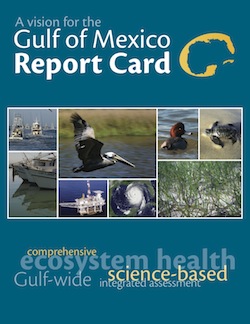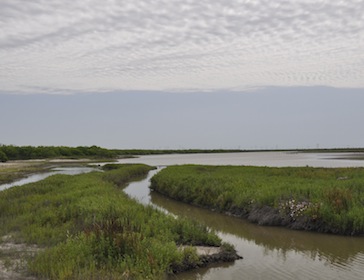What we do during the next ten years will affect the Gulf of Mexico for centuries to come.
Renowned oceanographer Sylvia Earle delivered that stark warning to attendees at the State of the Gulf of Mexico Summit 2011, held Dec. 5-8 in Houston, where participants appraised the ecosystem’s degraded health and discussed ways to restore it. A former scientist at the National Oceanic and Atmospheric Administration, Earle chairs the advisory board of the Harte Research Institute for Gulf of Mexico Studies (HRI) at Texas A&M University Corpus Christi, a conference sponsor.
“We are finding there are limits to what we can put into and take out of the Gulf,” she said. “We have the power to destroy and we also have to power to protect.”
Earle and other speakers stressed the importance of the Gulf of Mexico, the planet’s ninth largest body of water. The economy of its five coastal states – Texas, Louisiana, Mississippi, Alabama and Florida – would rank as the seventh largest in the world, worth about $234 billion annually. Ninety percent of offshore oil and gas in the U.S., and a third of our seafood – 1.2 billion pounds – plus 44 percent of the nation’s recreational catch come from the Gulf. Its coastal areas contain 50 percent of our wetlands, which provide critical habitat for commercial marine species, storm protection, and a natural water filtering system. More than half of the continental U.S. drains into the Gulf.
“This is the hardest working body of water in our country, bar none,” summed up Laura Huffman, director of The Nature Conservancy of Texas, a private land-conservation organization. But this hard worker is subject to a variety of indignities, among them dramatic population growth, climate change, decreased freshwater inflows and the ongoing effects of 2010’s Deepwater Horizon disaster.
Ensuring freshwater inflow to the Gulf
Huffman spoke of the critical connection between freshwater and the health of the Gulf. “The Gulf of Mexico is a drainage basin, and whatever happens in these many rivers and streams affects it. In Texas, we had the driest summer ever, with more people – 25 million – than ever before. That’s a lot of straws in our rivers, streams and lakes. Supply is fixed, so we’re going to have to drive use down.”
Freshwater inflow is one of the main drivers of the health of estuaries, said Susan Kaderka, a regional director for the National Wildlife Federation, and estuary health in turn drives the general health of the greater Gulf ecosystem. Policies governing freshwater distribution mostly fall to state governments, she added, where laws focus on consumptive uses of water. “We are a long way from balancing human consumptive needs with ecosystem needs.”
Texas only officially recognized in 2007 the need for environments to have water, and determining freshwater requirements for each river basin has been “a very bumpy road,” Kaderka said. We don’t even know for sure how much freshwater it takes to maintain bays and estuaries. We need to fund the science to support water-use decisions, she said, predicting that Texas will ultimately have to acquire and reserve water to meet inflow needs.
More people, more cargo
Many areas along the Gulf coast have seen population increases of 500 percent or more since 1960, said David Yoskowitz, a socio-economist with HRI. The population of Gulf Coast counties is 10.4 million; by 2025 it will be 12.1 million, he said, “like dropping another Houston on the coast in 15 years.”
According to the HRI, seven of every 10 pieces of cargo arriving from ocean transports in the U.S. come to one of the Gulf’s six major ports. Widening of the Panama Canal, scheduled for completion in 2014, will mean a 25 percent increase in that cargo, and the need for deeper ports.
At the same time, storms, land subsidence and sea-level rise threaten millions of dollars worth of port infrastructure. Port Fourchon in Louisiana, the busiest internodal energy port in the country, depends solely on Louisiana Highway 1, which a NOAA study shows will be closed 50 percent of the time by 2050.
Deepwater Horizon
A great deal of research has been done in the wake of the Deepwater Horizon disaster, a massive leak at an offshore oil platform in 2010 that continued for months, reported NOAA senior science advisor Paul Sandifer. Researchers have found tissue damage in fish and changes in microbial and plankton communities caused by the spill, as well as direct and indirect effects on human health and on the socio-economic fabric of coastal communities.
There is still much that researchers don’t know, Sandifer pointed out, including the interaction of chemically dispersed and non-dispersed oil with suspended sediments and marine snow (organic particles that rain through the water column and provide food for deep-dwelling creatures (oceanservice.noaa.gov/facts/marinesnow.html), effects of chemical dispersants on the marine environment and effects of the spill on plankton and near-shore environments.
“We weren’t prepared for Deepwater Horizon,” said William Hogarth, interim director of the University of South Florida’s Florida Institute of Oceanography, noting that a lack of adequate baseline data limits understanding of the effects of such events. “We need to be prepared for the next environmental catastrophe in the Gulf, but we still don’t have a plan in place, and our monitoring and response capacity is actually declining, in the Gulf and elsewhere.”
Earle echoed concerns about lack of data, not only in the Gulf, but for oceans in general. “Only two people have been to the deepest part of the ocean, and that was more than 40 years ago,” she said, and today, the only submersibles capable of reaching the deepest parts of the oceans are owned by other countries.
Offshore drilling in the Gulf isn’t going away, either. The U.S. Interior Department’s acting assistant secretary for land minerals management, Marcilynn Burke, reported that since June, 93 new shallow water and 234 deepwater leases have been approved, and another lease sale took place Dec. 14.
“World energy demand will grow 50 percent by 2035,” said Clint Moore, a vice president at ION Geophysical Corporation in Houston, and the Gulf of Mexico still has the most undiscovered, technically recoverable oil and gas – ahead of Alaska.
Disaster recovery
At the summit, federal officials announced the release of the final strategy report [PDF] from the Gulf Coast Ecosystem Restoration Task Force established by President Barack Obama on Oct. 5, 2010. “The strategy is a response to long-term degradation of the ecosystem,” said John Hakinson, executive director of the Task Force, which is opening an office in Mississippi.
Officials also announced at the summit that $50 million would be allocated to the U.S. Department of Agriculture Natural Resources Conservation Service for agricultural projects in seven Gulf river basins to improve water quality, conserve water, and create wildlife habitat.
The federal government is still in the process of determining liability for Deepwater Horizon and the cost of its damage in order to determine fines to be paid under the Oil Spill Pollution Act and the Clean Water Act.
… and beyond
Hogarth stressed that the Gulf environment needs not only to recover from the Deepwater Horizon disaster, but a reversal of long-term habitat loss, nutrient over-enrichment, overuse, the impacts of coastal development and climate effects.
“We are simply going to have to drive investment to the Gulf,” said Huffman, “Ironically, Deepwater Horizon created an opportunity by making NRDA [the federal Natural Resource Damages Assessment process] and Clean Water Act fines two sources of potential investment.”
However, unless one of the bills currently before both houses of Congress passes, those funds will be returned to the federal government’s general funds. “It is almost inconceivable that this money would not come back here to do what needs to be done,” Huffman said.“There won’t be five to 20 billion dollars coming to the Gulf through any other way. The ability to get the money from those fines is the single biggest opportunity for the Gulf in years.”
Adam Kolton of the National Wildlife Fund, a private conservation group, noted that about one percent of the federal budget covers environmental programs. He agreed that funding from financial penalties associated with the Deepwater Horizon event represents a major opportunity. “Fines under the Clean Water Act range from $1,100 to $4,300 per barrel,” he said.
A number of speakers pointed out that this kind of money has the potential to transform the Gulf Coast.
The four-day summit covered a wide variety of issues, including international boundaries, oil and gas development, planned offshore drilling in Cuba and research priorities. An oft-repeated theme was the value of ecosystem services provided by the Gulf of Mexico. Ecosystem services are the tangible contributions of an ecosystem; those provided by the Gulf include seafood, pharmaceuticals, water filtering, nutrients, nursery habitat for wildlife, carbon sequestration and quality of life, just to name a few.
The summit brought together leaders working in all areas around the Gulf. The first such conference,, held in 2006, launched the Gulf of Mexico Alliance, the first such regional governors’ group in the country, according to HRI director Larry McKinney. Then Deepwater Horizon created more awareness of issues that affect this sea.

“I began to see people come out of the woodwork,” McKinney said. “This group had a plan, that group had a plan, someone said we need to do this, another said we need to do that. I didn’t want to miss this opportunity, in a time of budget shortfalls, divisiveness and everything else we’re dealing with.”
A unified approach is being forged, he said – large non-governmental organizations now have common restoration priorities, 66 major academic organizations are collaborating, and the Task Force report means Gulf states agree for the first time on an action plan.
Keeping everyone moving forward is the goal of the Gulf of Mexico Report Card, an effort to develop a comprehensive, science-based, integrated assessment of the Gulf ecosystem. A team consisting of McKinney, HRI associate director Wes Tunnell, the consulting firm Harwell Gentile & Associates and the University of Maryland Center for Environmental Science will convene a workshop to divide the Gulf into manageable components, then develop a widely accessible report card for each.
“We hope the report card will be the glue that holds us together,” McKinney said. “The challenge is also not to get down into the trees – we have lots of people working on the trees – but to stay in the forest, looking at the larger marine ecosystem.”
+++++
Melissa Gaskill is an Austin-based writer whose work has been published by Nature News, Scientific American, Wildflower, Texas Parks & Wildlife Magazine, Smithsonian, Men’s Journal and others. She received a BS in zoology from Texas A&M University and an MA in journalism from the University of Texas at Austin. She was a 2009 Ocean Science Journalism Fellow at Woods Hole Oceanographic Institution and a fellow at the 2011 science seminar of the Metcalf Institute for Marine & Environmental Reporting, “Impacts of the Deepwater Horizon Oil Spill.”

